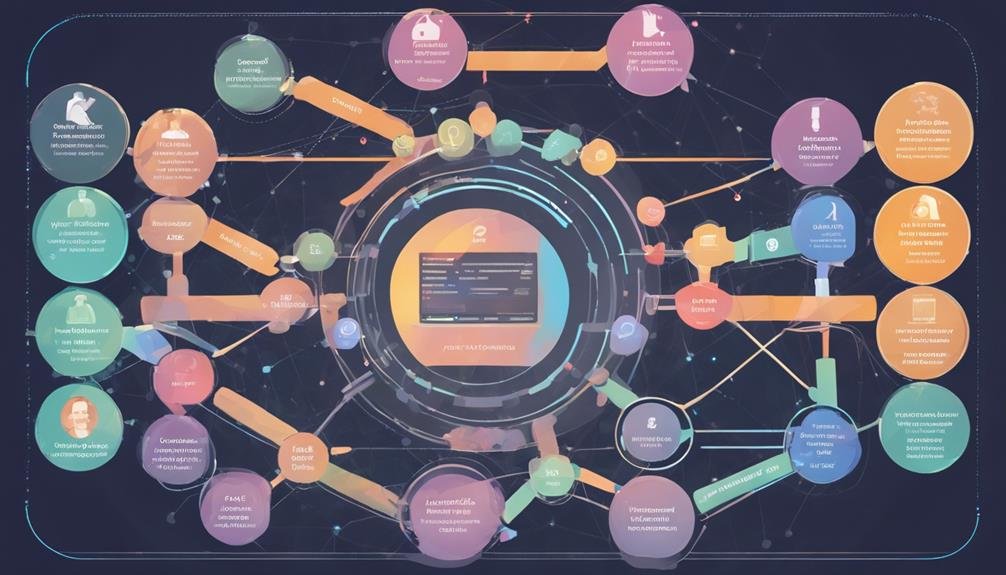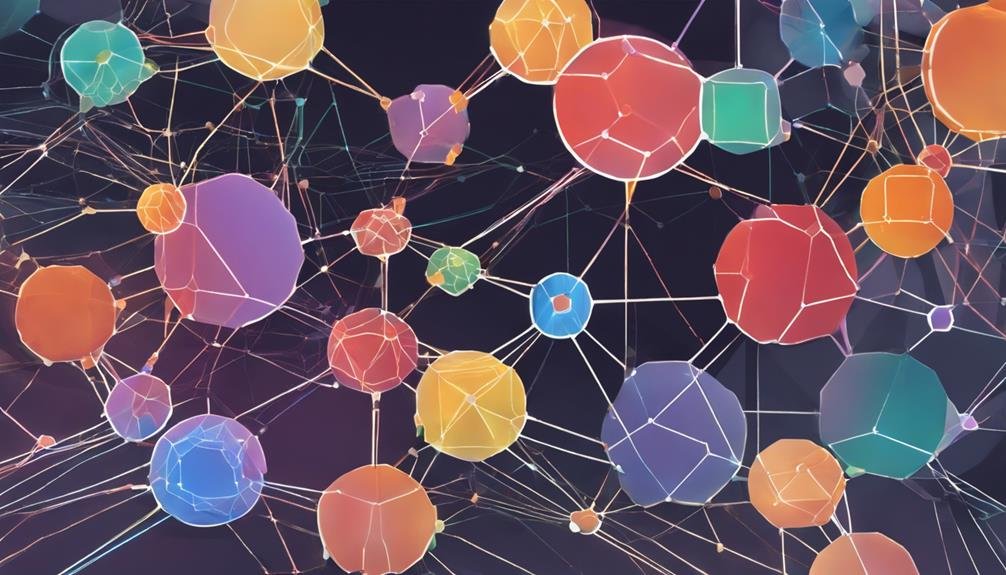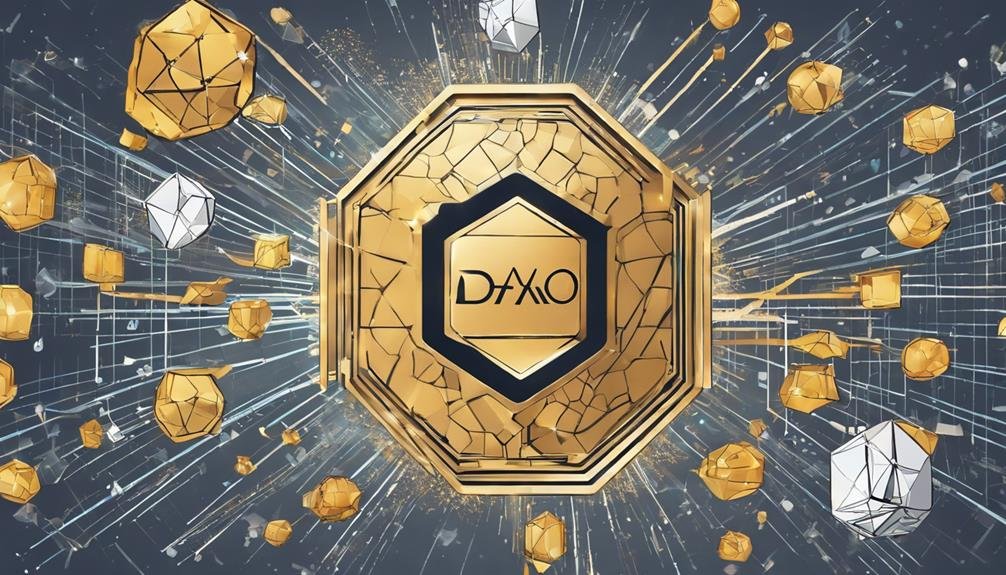In 2024, DeFi governance models shape decision-making in platforms like Yearn.finance, Aave, Compound, and MakerDAO. Governance tokens enable voting rights for protocol changes, with MakerDAO standing out for its structured approach. Tokens can be fairly launched or pre-mined, affecting power distribution. On-chain voting offers security and transparency, while off-chain balances speed and efficiency. MakerDAO uses Maker Improvement Proposals (MIPs), Aave employs multi-level participation, and governance tokens influence decision-making. Analyze voting participation, outcomes, and community engagement for insights into token performance. Token holders wield influence in decentralized finance evolution. Further insights await on DeFi governance models.
Table of Contents
Brief Overview of Defi Governance Models Comparison 2024
- DeFi governance models in 2024 will evolve with innovative voting mechanisms and community engagement strategies.
- Enhanced on-chain voting systems will ensure security and transparency in decision-making processes.
- Governance token distribution methods will impact decentralization and power dynamics within DeFi platforms.
- Structured governance frameworks like MIPs and Core Units will shape decision-making in leading DeFi protocols.
- Analysis of voting participation and proposal outcomes will be crucial for evaluating governance token performance in 2024.
Overview of DeFi Governance Models
When exploring the landscape of DeFi governance models, it becomes evident that these frameworks dictate the decision-making processes within decentralized platforms. Governance tokens are pivotal because they grant holders voting rights on protocol changes and upgrades. In the domain of DeFi, projects like Yearn. Finance, Aave, Compound, and the MakerDAO protocol implement distinct governance mechanisms. Governance in DeFi can be either informal or structured through proposals and voting mechanisms.
One notable example is the MakerDAO protocol, which stands out for its structured governance approach. MakerDAO utilizes Maker Improvement Proposals (MIPs) and core units to facilitate decision-making. This structured method allows for a systematic way of proposing and implementing changes within the protocol. By having a clear framework for governance, MakerDAO sets a precedent for other DeFi projects to follow suit in establishing robust governance structures. The balance between informal and structured governance is essential in ensuring the efficiency and effectiveness of decision-making processes in decentralized platforms.
Comparison of Governance Token Mechanisms

Comparing governance token mechanisms in DeFi projects reveals the diverse strategies employed by platforms like YFI, AAVE, COMP, and MKR to empower token holders with voting rights. These governance tokens allow holders to influence protocol decisions within decentralized finance platforms. Fair launch tokens guarantee equal access to token distribution, fostering a more democratic governance structure.
On the other hand, pre-mined tokens are allocated to initial stakeholders, like investors and team members, potentially concentrating power in a few hands. Holders of governance tokens in DeFi projects can actively participate in voting on proposals or choose to delegate their voting rights to other community members. The decision-making process in DeFi protocols heavily relies on the functionality and distribution of governance tokens, shaping the future direction of these platforms. Hence, understanding the nuances of governance token mechanisms is vital for anyone involved in DeFi governance.
Evaluation of Off-Chain Vs. On-Chain Voting

When evaluating off-chain versus on-chain voting in DeFi governance, consider the security of the voting process and the transparency in decision-making. Due to the decentralized nature of blockchain technology, on-chain mechanisms offer a higher level of security. In contrast, off-chain methods may lack the same level of transparency and immutability as on-chain processes.
Security of Voting
Using on-chain or off-chain methods for voting in DeFi governance significantly impacts the security of decision-making processes. On-chain voting guarantees transparency and immutability by recording votes directly on the blockchain, enhancing security against manipulation. However, it comes with the drawback of transaction fees and potential delays due to blockchain confirmation times, affecting decision-making efficiency.
In contrast, off-chain voting may offer quicker processes but poses security risks and susceptibility to manipulation. It might rely on external tools, introducing vulnerabilities and centralization concerns. When deciding between off-chain and on-chain methods, consider the trade-offs between speed, security, decentralization, and cost efficiency to make an informed choice that aligns with the overarching goals of the DeFi governance model.
Transparency in Decision-Making
To guarantee transparency in decision-making within DeFi governance, evaluating the effectiveness of off-chain versus on-chain voting mechanisms is vital. Off-chain voting offers flexibility and scalability in decision-making processes, often involving trusted third parties or community forums. However, on-chain voting ensures transparency and immutability by directly recording votes on the blockchain, eliminating the need for intermediaries.
Transparency is essential in DeFi governance to uphold trust and accountability among stakeholders. While off-chain methods may be more adaptable, on-chain voting provides a verifiable record of governance decisions, enhancing confidence in the system. Balancing the trade-offs between scalability and immutability is crucial in designing a governance model that fosters transparency and accountability in decision-making processes.
Governance Structures in Prominent DeFi Protocols

Comparing the governance structures of prominent DeFi protocols reveals diverse decision-making and community participation approaches. MakerDAO employs a decentralized governance model, utilizing Maker Improvement Proposals (MIPs) and Core Units for decision-making processes. Aave’s governance structure is evolving, offering different levels of participation and featuring a Guardian Account for emergency actions.
DeFi protocols like Yearn. Finance, Aave, Compound, and MakerDAO have governance tokens that enable holders to vote on proposals. Governance in DeFi involves informal decision-making processes, governance proposals, and challenges in achieving consensus. The voting mechanisms in DeFi governance can occur both off-chain and on-chain, with variations in transparency and efficiency affecting decision-making outcomes. These protocols showcase the complexities and nuances of decentralized governance within the DeFi ecosystem, highlighting the importance of community involvement and consensus-building in shaping the future of these platforms.
Performance Analysis of Governance Tokens

When evaluating the effectiveness of governance tokens in DeFi protocols, consider analyzing their voting participation, proposal outcomes, and community engagement metrics. Governance tokens like YFI, AAVE, COMP, and MKR grant holders the ability to influence decision-making processes within DeFi platforms. These tokens provide voting rights on proposals that can impact protocol upgrades and changes.
Incentivizing participation, governance tokens play an essential role in fostering active involvement from the community in shaping the future of DeFi platforms. Evaluating the performance of governance tokens involves looking at voting participation rates, the results of proposed changes, and the community engagement level. The value of governance tokens is closely tied to the success and adoption of their underlying protocols. By analyzing these key factors, stakeholders can understand how healthy governance tokens function within DeFi ecosystems.
Key Insights on DeFi Governance Models

When exploring DeFi governance models, it is essential to focus on the voting mechanisms that empower token holders to influence decisions. Token holder influence directly impacts decentralized decision-making processes within these protocols. Understanding how voting mechanisms function can give insight into the dynamics of DeFi governance structures.
Voting Mechanisms in Defi
Utilizing various voting mechanisms, DeFi governance models empower token holders to actively participate in decision-making processes for protocol changes and upgrades. In DeFi governance, on-chain governance allows token holders to directly vote through smart contracts, ensuring a transparent and decentralized decision-making process. Conversely, off-chain governance precedes on-chain voting, involving informal discussions and signaling among community members.
Delegated voting systems allow token holders to delegate their voting power to trusted representatives, streamlining the decision-making process. These voting mechanisms are designed to enhance transparency, decentralization, and community involvement in DeFi governance, fostering a collaborative environment where stakeholders have a say in shaping the future of the protocols they support.
Token Holder Influence
Token holders wield significant influence in DeFi governance models through their ability to vote on proposals or delegate their voting power. Governance tokens like YFI, AAVE, COMP, and MKR grant holders decision-making authority in protocol changes. Different mechanisms exist for token holders to participate in decision-making processes within DeFi governance models. The distribution and influence of governance tokens are affected by approaches such as Fair launch and pre-mine. These token holders play a vital role in shaping the direction and development of decentralized finance platforms. By leveraging their voting power, token holders can impact the trajectory of DeFi protocols, making them key players in the evolution of the ecosystem.
Decentralized Decision-Making
Facilitating decentralized decision-making in DeFi governance models empowers token holders to actively participate in shaping the future of decentralized finance platforms. Through on-chain voting mechanisms, holders of governance tokens in DeFi protocols can influence protocol changes. This process allows for transparent decision-making and fosters inclusive structures where the community’s voice is heard.
By engaging in DeFi governance, individuals can play a significant role in protocol upgrades and changes. Using governance tokens guarantees that decisions are made collectively by the community rather than centralized entities, promoting a more democratic approach to managing DeFi platforms. Decentralized decision-making is a fundamental aspect of DeFi governance models, emphasizing community involvement and consensus-building in protocol evolution.
Frequently Asked Questions
What Are Decentralised Models of Governance?
Decentralized governance models in DeFi involve token voting for community consensus. Transparency, accountability, and smart contracts promote user participation in decision-making. Governance tokens drive protocol changes, incentivizing delegated voting and shaping project direction.
What Is Defi Governance?
In DeFi governance, token holders vote on proposals through smart contracts. Community decisions drive the process, ensuring transparency and decentralized decision-making. Various governance structures, quorum requirements, and voting mechanisms shape how governance tokens influence decision-making in DeFi protocols.
What Is the Difference Between Centralized and Decentralized Governance Models?
In centralized governance, power is concentrated, and decision-making is quicker but less inclusive. In decentralized governance, power is distributed among many, promoting transparency, community involvement, and resilience. Each model has its trade-offs in efficiency and accountability.
What Is the DAO Governance Model?
In the DAO governance model, token holders drive decentralized decision-making through voting mechanisms. Smart contracts automate the proposal process, ensuring community involvement. Governance tokens enable on-chain governance, influencing decision outcomes and promoting transparency measures.
Conclusion
A striking statistic from comparing DeFi governance models reveals that over 70% of protocols have adopted on-chain voting mechanisms for decision-making. This data underscores the industry’s shift towards decentralized governance structures, emphasizing transparency and community participation. As the DeFi ecosystem continues to evolve, understanding the nuances of governance models will be essential for investors and stakeholders to navigate the complex landscape effectively. Stay informed and adapt to the changing dynamics of DeFi governance for long-term success.




